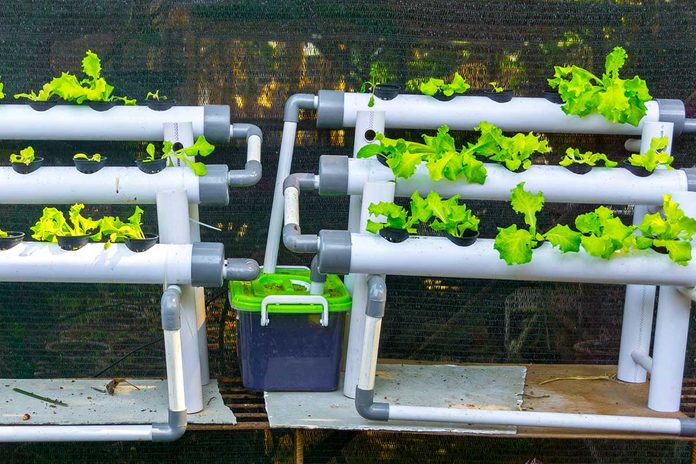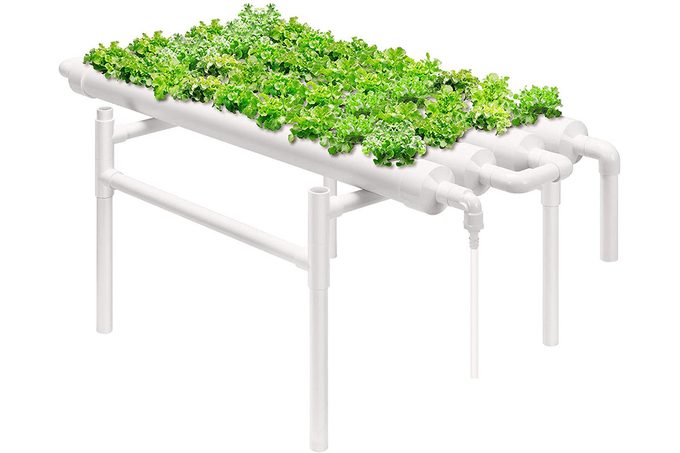What to Know About Hydroponic Gardens
Updated: Jul. 21, 2023

With impressive yields and efficient use of space, hydroponics may be the future of horticulture. Here's an overview of at-home hydroponic gardening.
The world’s population continues to grow, while the amount of arable land and fresh water available to produce sufficient food for billions of people is beginning to top out. One solution is hydroponic agriculture. This soil-less farming requires little space and water, can be done indoors or outdoors, and turns out much higher yields than traditional farming methods.
“Hydroponics is undoubtedly considered an approach to the future of agriculture,” says gardening author and horticulturist Brie Arthur. “In a world where scientists are working to solve the matters of food and natural resources in a sustainable and ecological way, hydroponics will play a major role.”
Next-generation hydroponic farming has captured the attention of everyone from developing nations to NASA engineers, but it also has a growing following among home gardeners. The benefits of reduced water and space requirements, plus increased yields, are attractive whether you’re trying to feed a nation, astronauts on Mars or your family.
Here’s what you need to know about hydroponic gardening.
On This Page
What Is a Hydroponic Garden?
“Hydroponics is a type of horticulture and a subset of hydroculture, which is a method of growing plants without soil by using mineral nutrient solutions in an aqueous solvent,” Arthur says. “Terrestrial plants may be grown with only their roots exposed to the nutritious liquid or the roots may be physically supported by an inert medium such as perlite, gravel or other substrates.”
Simply put, instead of growing plants in a bed of soil, you plant them in a structure that suspends their roots in a concentrated solution of water and nutrients. Pumps circulate the nutrient solution past the roots to maximize absorption.
Plants grown this way only need to develop a small number of fibrous roots rather than an extensive root system to get the water and nutrients they need. This turbo-boosts their growing power, allows you to plant more densely and, in the case of an indoor hydroponic garden, permits year-round gardening.
How Is a Hydroponic Garden Different from a Traditional Garden?

-
Hydroponic gardens do not require soil. Traditional gardens are planted directly in the ground, in raised beds or in soil-filled containers. Hydroponic gardens are planted in a water-based hydroponic system, which comes in various shapes and styles from simple bucket systems to tiers or tables.
-
Because their water supply is circulated through the system a number of times before it’s discarded, hydroponic gardens require significantly less water than traditional gardens. Where traditional gardens lose much of their water supply to drainage or evaporation, hydroponic garden systems allows for little water dispersion.
-
With supplemental lighting, hydroponic gardens can be cultivated indoors. Traditional gardens rely on sunlight for their plants’ photosynthesis requirements. Hydroponic gardens can survive under special grow lights, even indoors. “Any location with sufficient light and access to electricity is an opportunity waiting to happen,” says Arthur.
-
Tier or shelf hydroponic systems allow you to grow the same number of plants as a traditional garden in a fraction of the space. Outdoor plants need plenty of room to expand their root systems and capture enough sunlight. The nutrient-rich solution in hydroponic gardening (and supplemental lighting indoors) ensures that plants get the macro- and micronutrients they need even when densely spaced.
-
Hydroponic gardens have no weeds and dramatically fewer pests and diseases. What pests and diseases you do encounter are easier to manage organically, according to Arthur.
-
Indoor hydroponic gardens can be cultivated all year round. Except in the most temperate growing zones in the U.S., traditional outdoor gardens have an annual growing season.
-
Hydroponic gardens require a solution of macro- and micronutrients specially formulated for this type of soil-less agriculture. “Micronutrients are needed in small quantities but are as important as macronutrients,” explains Arthur. “Most fertilizers for soil-based growing focus on the macronutrients and don’t include micronutrients, since it’s assumed these will come from the soil and other amendments.”
Pros and Cons of Hydroponic Gardens
There are many benefits to hydroponic gardens, but also a few drawbacks. Consider both before taking the plunge:
Pros
- High yields. Arthur notes that the world record holder for most ripe tomatoes at one time on one hydroponic tomato plant is 32,000. That would be hard to beat with a single tomato plant in your backyard!
- Limited water requirements.
- Limited space requirements.
- Complete control over the environment (in the case of an indoor hydroponic garden).
- Option of gardening indoors for a 12-month growing season.
- Little maintenance needed once the system is up and running.
- A science-focused project that can include the whole family. “My mechanically inclined husband is intrigued by the pumps and electrical systems that traditional gardens don’t offer,” says Arthur, “while my son enjoys mixing and applying the nutrient solutions to see how the plants react.”
Cons
- Initial setup costs can be high, especially for a larger garden. Indoor systems also require grow lights and fans for ventilation.
- Not all plants take well to hydroponic techniques, including root vegetables.
- It will take time to learn the ins and outs of your system, understand the nutrients your plants need, get on top of the water changes, and adopt a habit of monitoring your plants and their environment for optimal growth.
- There is little leeway for equipment failure or mistakes. If a water pump goes out or you make an error calculating the nutrient solution or water change, your entire garden can die in hours.
Starting a Hydroponic Garden
- The first step when starting a hydroponic garden is deciding what kind of plants to grow, and how many. Certain plants thrive with specific hydroponic methods, so match the type and size of the system to the type and number of plants. Arthur suggests starting off with easy plant options like leafy greens, tomatoes, cucumbers and basil or other herbs.
- Then choose the type of hydroponic system. You can build a DIY version with separate parts or purchase a kit. According to Arthur, the most popular home hydroponic setups are deep-water submersion, drip and ebb-and-flow.
- Take time to get to know how your system works and learn the right nutrient solution for your specific plants. There can be a steep learning curve when you start a hydroponic garden, so do research ahead of time to decrease the margin of error.
- Plant your garden and begin monitoring the water (pH and nutrient levels), environment (temperature, light and humidity) and plants (burns, disease or pests) carefully for at least a few weeks until you start to get the hang of it. An indoor hydroponic garden is easier to control than an outdoor one, notes Arthur, so beginners may want to start off with an indoor setup.
Finally, stand back and watch your garden grow!
